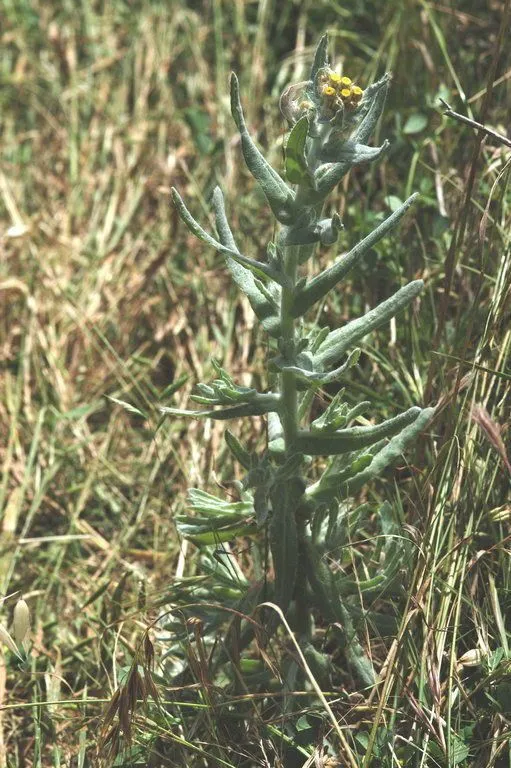
Author: (Kunth) Anderb.
Bibliography: Opera Bot. 104: 148 (1991)
Year: 1991
Status: accepted
Rank: species
Genus: Pseudognaphalium
Vegetable: False
Observations: W. Canada to C. America
The Cotton-batting-plant, scientifically known as Pseudognaphalium stramineum, is a distinct and noteworthy member of the Asteraceae family. First described in the work “Opera Botanica” vol. 104, on page 148, in the year 1991 by the botanist Anderb., who built upon the foundational classification provided by Kunth, this species has captivated botanists and plant enthusiasts alike with its unique characteristics.
Thriving in a wide geographical range, the Cotton-batting-plant is native to regions extending from Western Canada down through Central America. This broad distribution highlights its adaptability to varied climatic conditions and terrains, signifying its robustness and ecological versatility.
Belonging to the diverse Asteraceae family, which is renowned for its composite flowers, the Cotton-batting-plant stands out due to its fluffy, cotton-like appearance that resembles batting used in quilts. This unique trait not only gives the plant its common name but also aids in seed dispersal, as the fluffy structures can be carried by the wind, ensuring propagation over extensive areas.
The plant typically features clusters of small, yellowish or creamy flowers that are surrounded by dense, white, woolly hairs. These hairs create a protective layer, shielding the flowers and seeds from harsh environmental conditions, such as intense sunlight and drying winds. Additionally, this woolly covering can aid in retaining moisture, allowing the plant to survive in less hospitable regions.
In botanical studies and ecological observations, Pseudognaphalium stramineum has been noted for its potential medicinal properties, common among many members of the Asteraceae family. While traditional uses might vary, it is often explored for its anti-inflammatory and antimicrobial effects, showcasing the plant’s beneficial contributions beyond its aesthetic appeal.
The Cotton-batting-plant represents the intricate beauty of nature’s adaptations, serving as a testament to the evolutionary marvels within the plant kingdom. Its presence across a vast range underscores both its resilience and the delicate balance required to thrive in diverse environments.
Eng: annual cudweed, cotton cudweed, cotton-batting-plant, cottonbatting cudweed, cottonbatting plant, cotton-batting cudweed, cotton-batting plant
Fra: gnaphale paille
En: Cotton-batting-plant, Cottonbatting plant, Annual cudweed, Cotton cudweed, Cottonbatting cudweed, Cotton-batting cudweed, Cotton-batting plant
Fr: Gnaphale paille
Taken Oct 10, 2015 by EOL − brettstevenson (cc-by-nc)
Taken Aug 27, 2020 by Natasha Donnelly (cc-by-sa)
Taken Jul 22, 2020 by le rouzic (cc-by-sa)
Taken Feb 21, 2008 by EOL − Keir Morse (cc-by-nc-sa)
Taken Aug 3, 2015 by EOL − Don Loarie (cc-by)
Taken Mar 12, 2010 by EOL − Gary A. Monroe (cc-by-nc)
Taken Jan 7, 2015 by EOL − Zoya Akulova (cc-by-nc)
Taken Nov 18, 2015 by EOL − Don Loarie (cc-by)
Taken Mar 29, 2014 by EOL − Lew Stringer (cc-by-nc)
Taken Jun 10, 2013 by EOL − BJ Stacey (cc-by-nc)
© copyright of the Board of Trustees of the Royal Botanic Gardens, Kew.
© copyright of the Board of Trustees of the Royal Botanic Gardens, Kew.
Taken Jan 7, 2015 by EOL − Zoya Akulova (cc-by-nc)
Taken Jul 9, 2019 by Aleen koji (cc-by-sa)
Taken Jan 7, 2015 by EOL − Zoya Akulova (cc-by-nc)
Taken Mar 29, 2014 by EOL − linghe (cc-by-nc)
Taken Aug 20, 2022 by Frade Pedro (cc-by-sa)
Taken Feb 21, 2008 by EOL − Keir Morse (cc-by-nc-sa)
Growth habit>: Forb/herb
Family: Myrtaceae Author: (F.Muell.) K.D.Hill & L.A.S.Johnson Bibliography: Telopea 6: 402 (1995) Year: 1995 Status:…
Family: Rubiaceae Author: Pierre ex A.Froehner Bibliography: Notizbl. Bot. Gart. Berlin-Dahlem 1: 237 (1897) Year:…
Family: Sapindaceae Author: Koidz. Bibliography: J. Coll. Sci. Imp. Univ. Tokyo 32(1): 38 (1911) Year:…
Family: Asteraceae Author: A.Gray Bibliography: Pacif. Railr. Rep.: 107 (1857) Year: 1857 Status: accepted Rank:…
Family: Fabaceae Author: Medik. Bibliography: Vorles. Churpfälz. Phys.-Ökon. Ges. 2: 398 (1787) Year: 1787 Status:…
Family: Aspleniaceae Author: (Cav.) Alston Bibliography: Bull. Misc. Inform. Kew 1932: 309 (1932) Year: 1932…